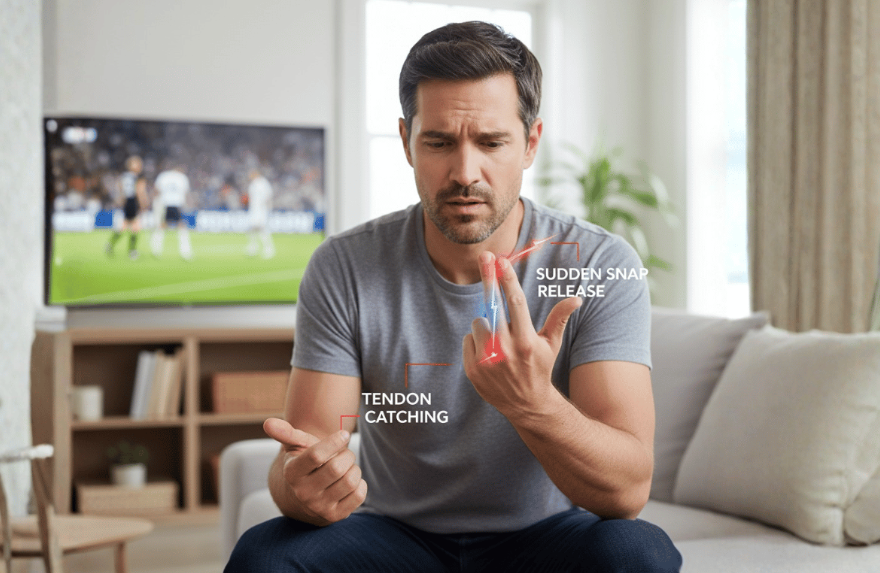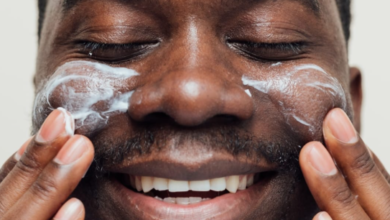
How Do You Get Trigger Finger?
Have you ever felt a strange catching or locking sensation in your finger?
One moment it’s moving smoothly, and the next, it gets stuck in a bent position before suddenly snapping straight.
If this sounds familiar, you might be experiencing a condition commonly known as trigger finger and medically known as stenosing tenosynovitis.
How trigger finger develops
Each of your finger tendons is surrounded by a protective covering called a tendon sheath.
At the base of your finger, on the palm side, this sheath forms a small tunnel known as the A1 pulley. This pulley is vital for keeping the tendon in place as it moves.
Trigger finger occurs when this A1 pulley becomes inflamed and thickens. At the same time, the tendon itself may develop a small nodule or swelling.
As you bend and straighten your finger, this swollen part of the tendon has to squeeze through the narrowed pulley. This friction can cause pain and a clicking sound.
If the nodule gets large enough, it can become temporarily trapped, causing your finger to lock in a bent position.
The triggering happens when you force the nodule through the tight pulley, causing the finger to snap straight.
Causes and Risk Factors
- Repetitive Hand Use: Activities that require forceful or repeated gripping, like using power tools, gardening, or playing certain musical instruments, can strain the tendons and their sheaths.
- Medical Conditions: Certain health issues are strongly linked to trigger finger. People with diabetes, rheumatoid arthritis, and gout are more likely to experience it.
- Age and Gender: The condition is most common in people between the ages of 40 and 60. It also tends to affect women more often than men.
- Previous Hand Injuries: An injury to the base of your finger or palm can sometimes lead to inflammation that contributes to trigger finger.
Symptoms and Complications
- A tender lump at the base of the affected finger on the palm side.
- A popping or clicking sensation as you move your finger.
- Stiffness in the finger, especially in the morning.
- The finger locking in a bent position, which you might have to straighten with your other hand.
A common question is, can a bent finger from the trigger finger be straightened?
In the early stages, you can usually straighten the locked finger, though it might snap suddenly and be painful.
As the condition progresses, however, straightening the finger can become increasingly difficult.
Treatment Options
- Rest: The simplest step is to avoid activities that involve repetitive gripping or strain on the hand for a few weeks.
- Splinting: Wearing a splint, particularly at night, can keep the affected finger in a straight position. This prevents it from locking while you sleep and allows the tendon to rest.
- Medication: Over-the-counter nonsteroidal anti-inflammatory drugs (NSAIDs) like ibuprofen can help reduce pain and inflammation.
- Steroid Injections: A corticosteroid injection directly into the tendon sheath is a very common and often effective treatment. It works by reducing inflammation, allowing the tendon to glide freely again. Many people experience significant relief after just one injection.
If these methods don’t provide lasting relief, a minor surgical procedure called a “trigger finger release” may be recommended.
During this procedure, a surgeon makes a small incision in the palm and cuts the constricted A1 pulley, giving the tendon more room to move.
See also: A Lifetime of Smiles: Your Guide to Optimal Oral Health
Massage and Therapy
Gentle massage can be a helpful part of managing the condition. Massaging the tender area at the base of the finger can help break down scar tissue and improve blood flow.
Stretching exercises, prescribed by a doctor or physical therapist, can also help maintain the finger’s mobility and reduce stiffness. It’s important to be gentle.
Aggressive massage could potentially worsen the inflammation.
Always consult with a healthcare professional to ensure you are performing the right type of massage and exercises for your specific situation.
Prevention and Management
While it’s not always possible to prevent trigger finger, especially if it’s related to an underlying medical condition, you can take steps to reduce your risk.
Here are a few tips for how to avoid trigger finger:
- Take Regular Breaks: If you’re performing a task that requires sustained gripping, take frequent breaks to rest your hands and stretch your fingers.
- Modify Your Grip: Use padded gloves or build up the handles of tools to reduce the amount of force you need to apply.
- Warm-Up Your Hands: Before starting an activity that is demanding on your hands, do some simple stretches to prepare the tendons.
- Maintain Overall Health: Managing conditions like diabetes and rheumatoid arthritis effectively can lower your risk of developing complications like trigger finger.
If Left Untreated
Over time, the condition can worsen. The pain and locking may become more frequent and severe.
In advanced cases, the finger can become permanently stuck in a bent or, less commonly, a straight position.
This is known as a fixed flexion contracture and can significantly impact your ability to perform daily tasks.
The constant inflammation can also lead to scarring around the tendon and sheath, making treatment more complex.
Occupational Link
Due to its strong connection with repetitive and forceful hand movements, trigger finger is frequently seen in certain professions.
Workers in manufacturing, construction, and agriculture, who often use vibrating tools or perform forceful gripping actions, are at a higher risk.
For workers in these fields, early intervention is key. Making ergonomic adjustments to workstations or tools can prevent the condition from becoming debilitating.
Employers can also play a role by promoting hand safety and providing appropriate equipment.
Start Practising Preventive Habits Today
Trigger finger can be a frustrating and painful condition, but it is highly treatable. Whether it’s through simple rest, targeted exercises, or medical treatment, relief is within reach.
In the meantime, incorporating preventive habits like taking breaks and modifying your grip can make a significant difference in keeping your hands moving smoothly for years to come.




